Tillandsia magnispica
Click thumbnails for full size, scaled to a new window.
Tillandsia magnispica
"Only recently determined that this species is in Australia. Previously mislabelled."
Species from Mexico.
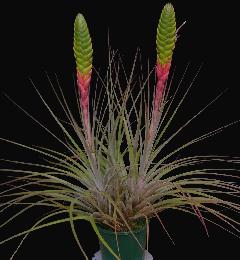
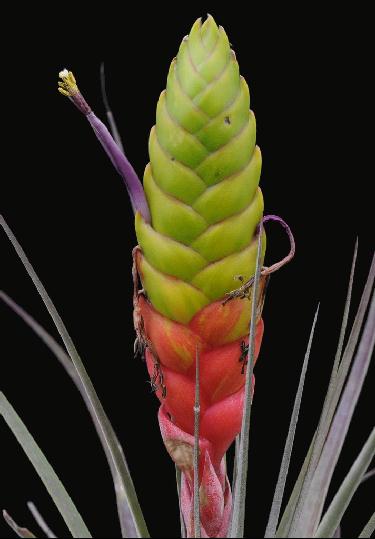
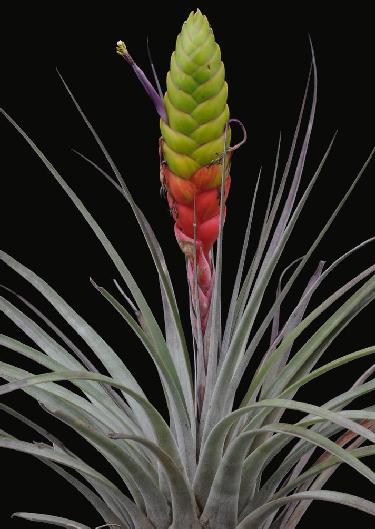
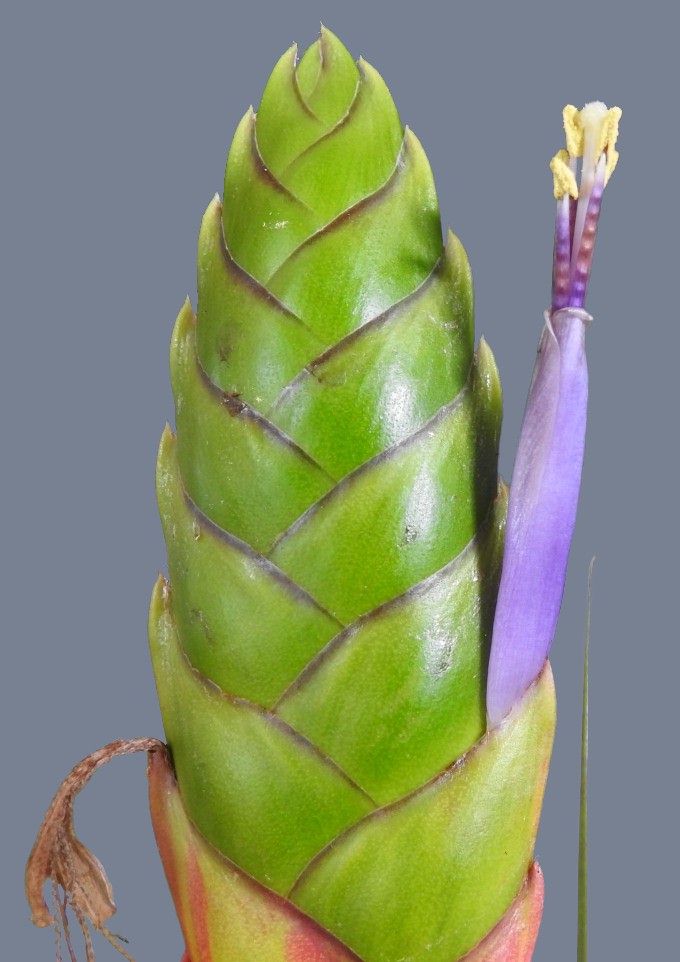
| Chris Larson 04/10 |
Peter Tristram 02/11 |
Jenny Brittain 02/16 |
Peter Tristram ... "I recently bought this plant from Nev at the Gold Coast meeting, so it’s really a post from Nev! It had the ‘jalsico-monticola small form’ label and appears to be another T. magnispica, the presence of which in Australia was discovered last Easter in Albury."
Jenny Brittain ... "I love the markings on the pollen stem."
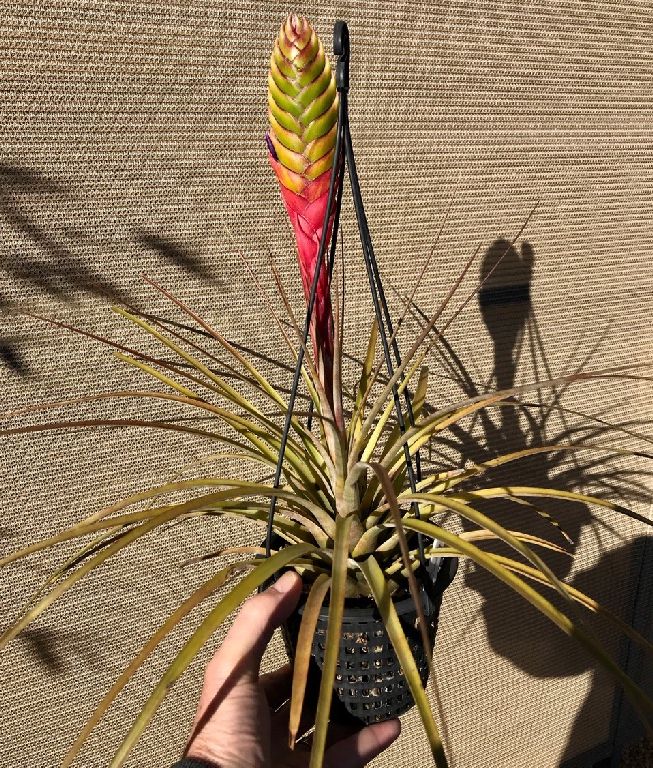
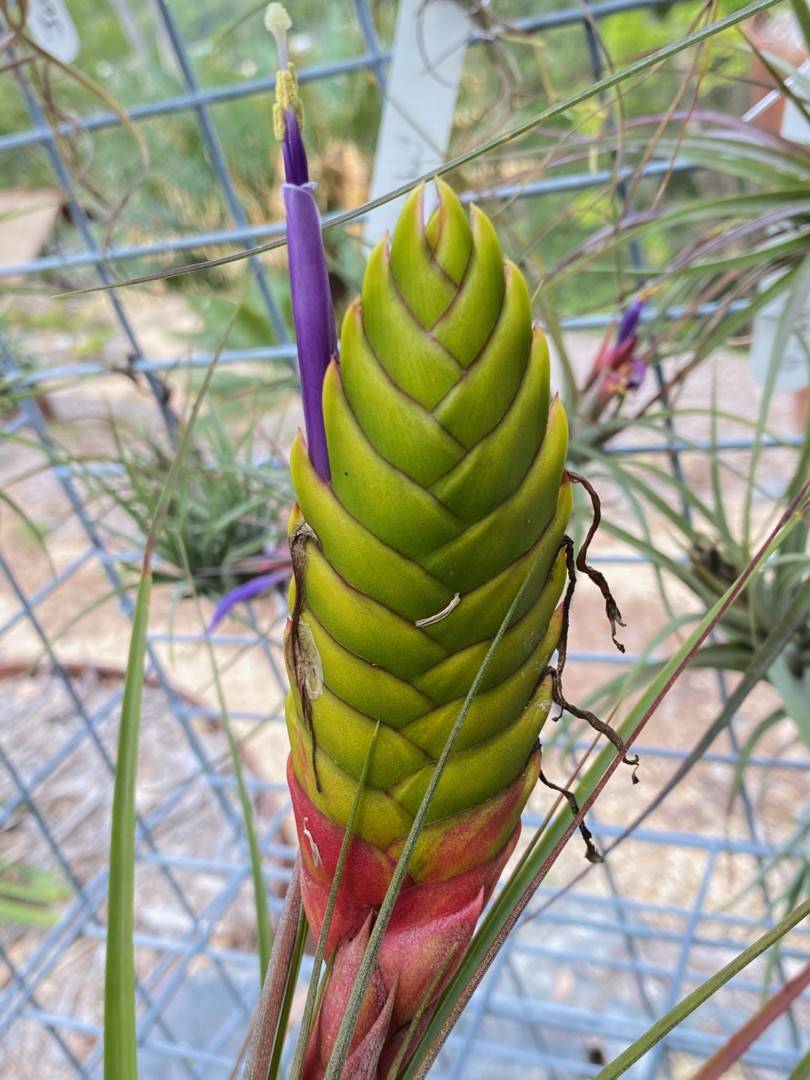
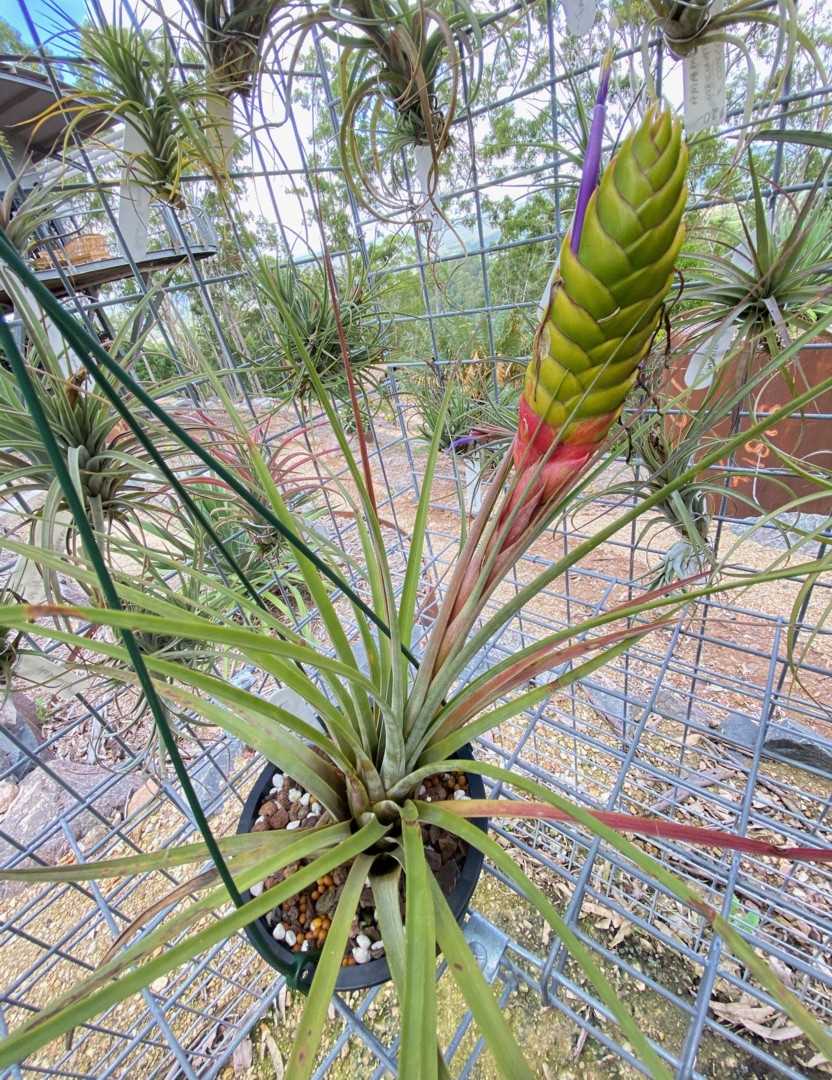
| Ray Clark 06/19 |
Dale Dixon 02/21 |
Tillandsia magnispica Espejo et Lopez-Ferrari, sp. nov. Acta Bot. Mex. 86: 1-7. 2009
Herba epiphytica, acaulis, rosulata, florens usque 80 cm alta. Folia numerosa, vaginae distinctae, ellipticae, 7-10 cm longae, 4-5 cm latae; laminae anguste triangulari-lanceolatae, 37-55 cm longae, 1.3-1.7 cm latae, involutae, distaliter arcuatae; scapus inflorescentiae erectus, teres, 29-50 cm longus; inflorescentia simplicissima; spica anguste elliptica, complanata, 18-25 cm longa, 3.5-4.5 cm lata; bracteae florales distichae, imbricatae, late ovatae, 5-5.5 cm longae, 4-4.5 cm latae, carinatae, supera virides, basalia incarnatae, nervatae; petala 7-8 cm longa, ca. 1 cm lata, violacea; stamina subaequalia, exserta, stylus exsertus.
Plants stemless, epiphytic, flowering up to 80 cm high;
leaves numerous, forming a tank rosette ca. 40 cm in diameter;
leaf sheaths elliptic, 7-10 cm long, 4-5 cm wide, glabrous and dark brown adaxially, glabrous and light brown abaxially;
leaf blades narrowly triangular to lanceolate, 37-55 cm long, 1.3-1.7 cm wide at the widest part, coriaceous, lepidote, tapering to a long filiform and acuminate apex, margins involute;
inflorescence erect, simple, to 75 cm long;
scape 29-50 cm long, erect, stout, ca. 1 cm in diameter,
scape bracts polystichous, imbricate, rose-coloured, the lower foliaceous, the blades similar to the leaves, the upper bladeless or with much reduced blades, linear-subulate, the sheaths ovate, to 5 cm long and 3 cm wide, concealing the scape;
spike erect, narrowly elliptic to oblong, 18-25 cm long, 3.5-4.5 cm wide, complanate, up to 28 flowered, larger than the leaves,
floral bracts distichous, imbricate, longer than the sepals, glabrous, the basal ones rose-coloured, the upper ones bright green, marginally wine-coloured, widely ovate, conduplicate, carinate, acuminate, with a pungent apex, conspicuously nerved when dried, 5-5.5 cm long, 4-4.5 cm wide;
flowers, erect, sessile, successive;
sepals elliptic to oblong, glabrous, acute, the posterior tines carinate and shortly connate at the base, pale green, 3.4-4 cm long, 1-1.2 cm wide;
petals narrowly oblong to spatulate, glabrous, obtuse, free, violet at the upper half, white at the base, 7-8 cm long, ca. 1 cm wide,
stamens subaequal, filaments linear, 8.7-9 cm long, violet and complanate at apical end, white at the base, anthers oblong, yellow, 4.5-5 mm long;
ovary ovoid, green, ca. 7 mm long, 5 mm in diameter; style white, 8.7-9.5 cm long; stigma white, trilobulate, spiral conduplicate (Brown & Gilmartin, 1984), 4.5-5 mm in diameter; fruit not seen.
Type: Mexico, Oaxaca, distrito de Pochutla, municipio de San Pedro Pochutla, alrededores de Toltepec, ca. 4.5 km despues de San Jose Chacalapa, carretera Pochutla-Miahuatlan, 15°5l'47" N; 96°27'58" W 285 m s.n.m., selva mediana, 10 VIII 2001, A. Espejo, A. R. Lopez-Ferrari, J. Ceja y A. Mendoza R. 6312 (Holotype (in three sheets): UAMIZ; Isotype IEB).
Paratypes: Mexico, Oaxaca, distrito de Pochutla, municipio de San Pedro Pochutla, N of Pochutla, 1981, C. S Gardner 1445 (SEL, US, line drawing by Gard¬ner, 1982); distrito de Pochutla, municipio de San Pedro el Alto, 18 km al S de San Miguel Suchistepec, sobre la carretera a Pochutla, 1700 m s.n.m. Bosque de Pinus oocarpa sobre ladera metamorfica, 22.IX.1965, J. Rzedowski 20648 ENCB(x3), LL, MICH, TEX).
Tillandsia magnispica is endemic to Oaxaca (Espejo-Serna et al., 2007 p. 138), and known only from the Municipalities of San Pedro Pochutla and San Pedro el Alto, District of Pochutla (Fig. 4).
The material of the new species has been identified by some authors (Gardner, 1982, pp. 145-146; McVaugh, 1989, p. 58) as Tillandsia jaliscomonticola Matuda (Figs. 2, 3A), a taxon only known from Colima, Jalisco, and Michoacan (Espejo et al., 2004, p. 63) (Fig. 4 and Appendix), however the differences between the two taxa showed in the table 1 and figures 1, 2, and 3, are conspicuous.
Table 1. Comparative characteristics of T. magnispica and T. jaliscomonticola.
| Disection | T. magnispica | T. jaliscomonticola |
| foliar sheaths | 7-10cm long, 4-5cm wide | 11.5-15cm long, 5.5-6cm wide |
| spike number | 1 | 1-3 |
| spike width | 3.5-4.5cm | 6-8.2cm |
| petal length | 7-8cm long | 6-7cm long |
| stamens | subequal | unequal |
| distribution | Oaxaca | Colima, Jalisco and Michoacan |
Tillandsia magnispica in Australia by P. Tristram in J Brom Soc 61(4): 194-5. 2011
Every 2 years a group of Tillandsia crazies attends the 'Tillnuts' conference somewhere 'neutral' in Australia. Those who attended the BSI World Conference in Cairns might have watched an abridged version of this auspicious event, the day before the conference proper.
Observers would have watched from the 'outer circle', while in the 'inner circle' were the Nutters doing their thing.
Among the many and varied topics this time were presentations/discussions on the Tillandsia fasciculata group, always a hot topic. With lots of flowering plants to examine, one became the centre of attention. Was it a form of T. fasciculata (Schwartz)? Was it T. jalisco-monticola (Matuda)? There was one sure way to solve this: the magnificent inflorescence was unceremoniously snapped off and the floral bits ripped apart. These were then spread like plunder among the 17 attendees. Descriptions, courtesy of Uncle Derek's Tillandsia DVD, were scrutinised, measurements taken, even a microscope employed and much discussion entered into.
During the examination process, T. jalisco-monticola was eliminated immediately due, especially, to the narrower dimensions of the leaves and of the inflorescence and the presence of partly fused posterior sepals, free in T. jalisco-monticola. The incredibly variable T. fasciculata seemed a last resort, a disappointing possibility, but fortunately the author was familiar with the recently published description of T. magnispica so that plant's description was referenced. From leaf sheath to flower, BINGO, Perfect match! We're not so nuts after all!
Interestingly, original specimens can be traced to the 1980's, labeled T. fasciculata var. unispica as one remembered name, most likely others including T. jalisco-monticola or T. sp. as well. The plant always has a single, tricolour spike and is easier to grow in cooler climes than the chunkier, more temperamental T. jalisco-monticola. So, the outcome was conclusive and agreement unanimous, rare in this deranged group:
the plant in question was, without a doubt, the recently described Tillandsia magnispica.
Fortunately there was a second plant also in bloom or remaining evidence would have been destroyed. The photos are of the examined plant's 'sibling' pup as well as some floral parts for the always discerning taxonomists.
Rarely do plants of questionable identity so accurately fit a description.
Updated 11/02/21






